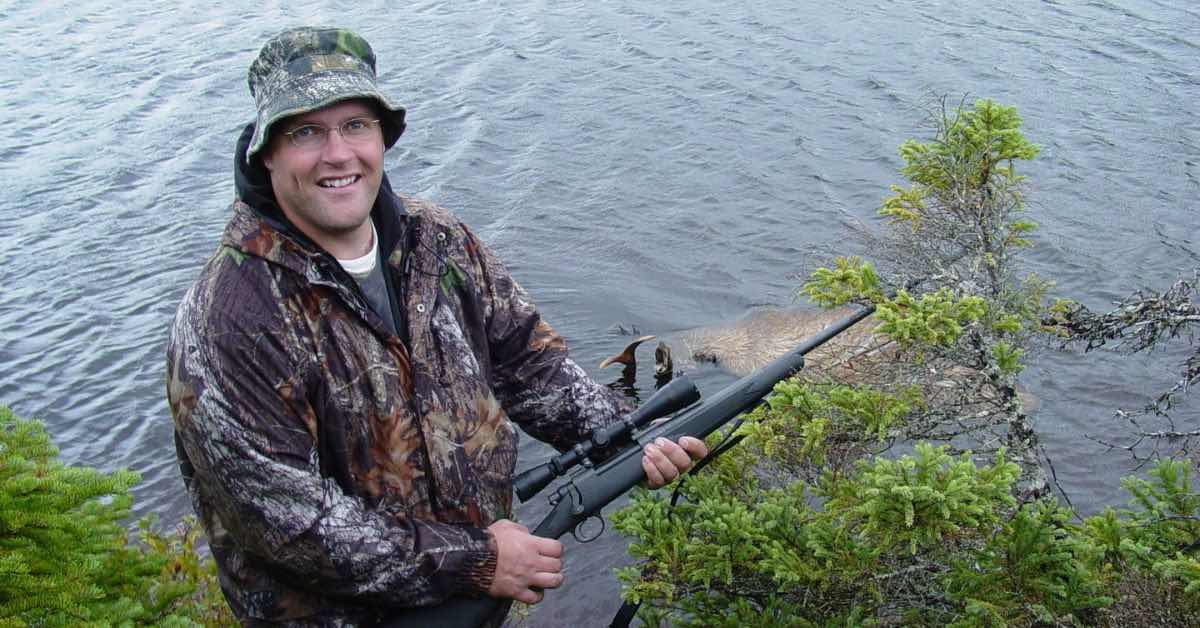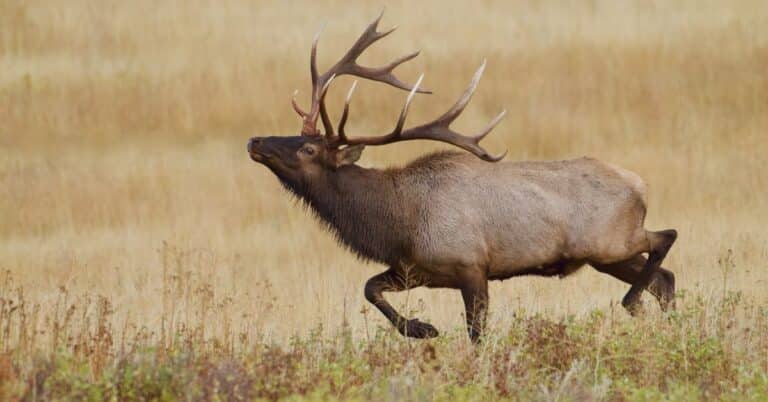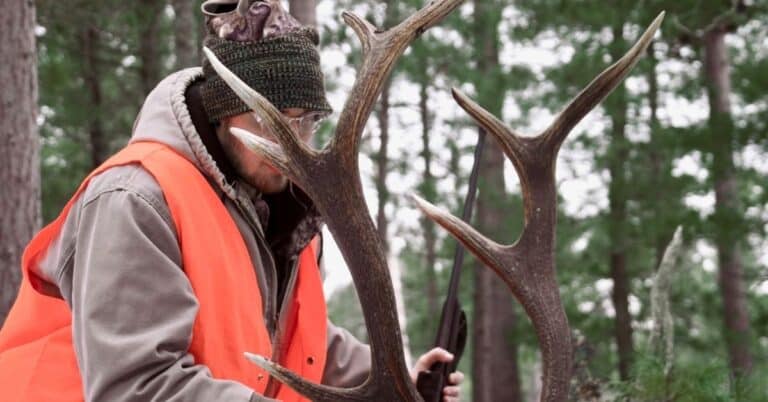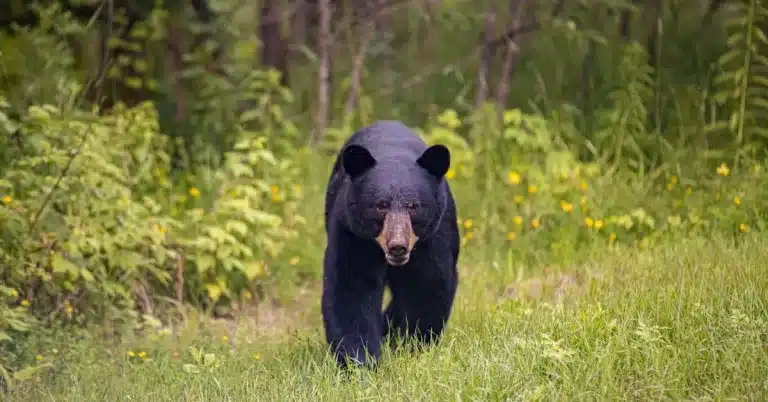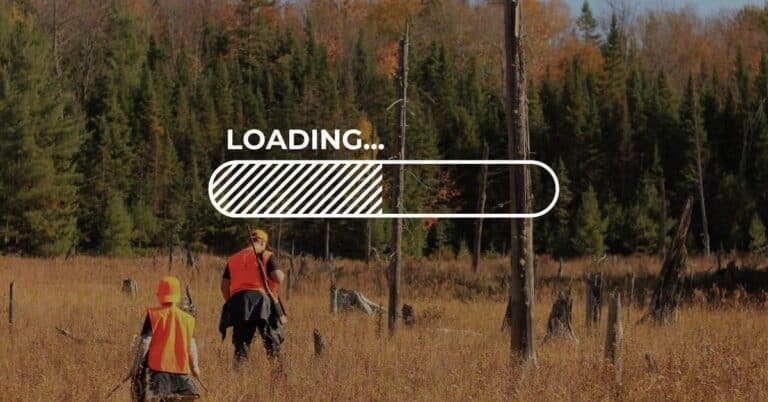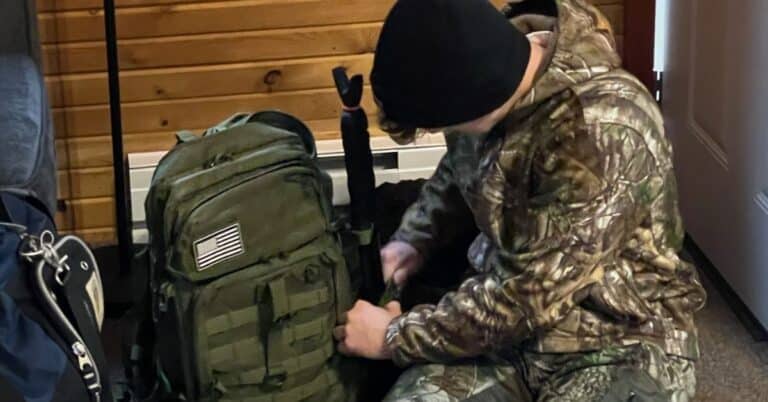Successful Moose Hunting in Newfoundland
Big Game Hunt of a Lifetime:
My dream moose hunt adventure was set in motion at an expo in Grand Rapids, Michigan with two hunting friends. The journey ahead would take place over 2,000 miles away near Daniel’s Harbor, Newfoundland, Canada. I set my mind on a trophy eastern Canadian moose – the largest member of the deer family. But the story unfolds over a year and a half of saving, planning, and finally the special moose-hunting of Newfoundland trip of a lifetime.
Booking Dream Fall Hunts
Every year, my city hosts a Hunting Expo that draws hunting outfitters from across the U.S. and Canada. Eager for ideas to plan a future hunt, my neighbor and partner in crime joined me at the expo, where we engaged with various outfitters. Amidst the conversations, a particularly engaging dialogue unfolded with a guide from Newfoundland, Canada. For more than two hours, we delved into discussions, explored photos of their camps and hunts, and established a strong connection. This encounter culminated in a decisive commitment – I booked my dream hunt for the following year.
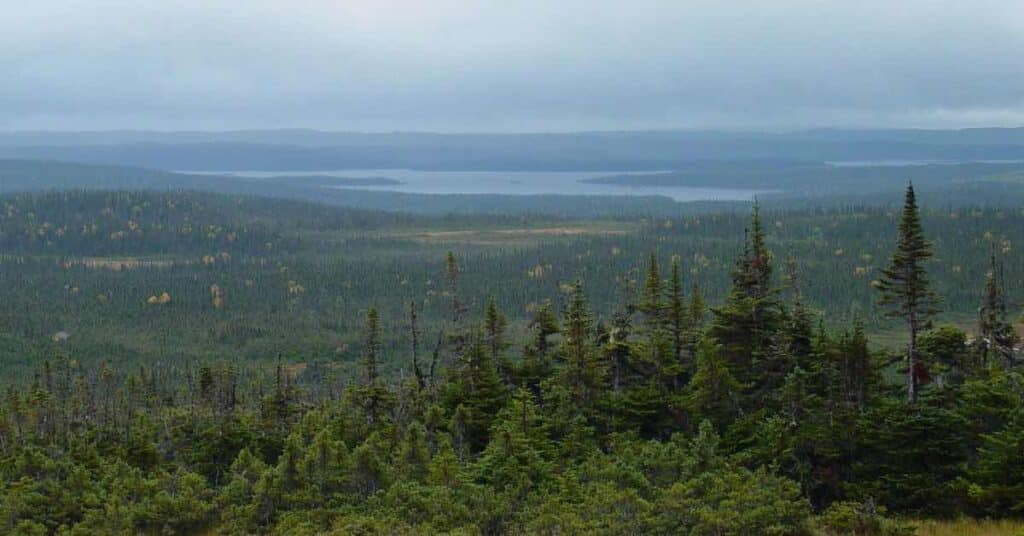
Selecting a Guide: Portland Creek Outfitters
Choosing a hunting guide can make or break your success. I chose Portland Creek Outfitters out of Newfoundland to serve as my guide. They offer a One on One guide ratio for their clients who are very kind and willing to go the extra mile to make your hunting experience a memory that will last forever. Each client is assigned to a guide who is a well-seasoned hunter and willing to offer a kind hunting experience. Whether hunting with a rifle or a bow, each guide made it a priority to do their best to get each hunter within close range of a moose by various methods of calling or opting for a spot and stalk.
Accommodations and Hunting Packages
The big game hunting location for Portland Creek Outfitters is located in the Long Range Mountains in the Great Northern Peninsula of Newfoundland. They offer a complete package of hunting which includes Moose hunting, Woodland Caribou and Black Bear Hunts which can be added as a package deal. The locations of the remote camps serve as the base camp which hunters call home for the duration of their hunting adventure.
My two friends, both named Doug, made plans to hunt complete packages with their Caribou tag first, then Moose. I decided to focus solely on Moose and a Black Bear tag, intending to spend the week searching for signs of recent Moose kills, hoping to spot a Black Bear feasting on the remains.
Preparing for Trophy Moose Hunts
Over the next year and a half, I would be planning not only on becoming a moose hunter but also on the journey to get there. We had decided to drive the entire distance, including a ferry crossing of the Atlantic Ocean, to Newfoundland, Canada.
To fund this adventure, I chose to take on a part-time job with a well-known sporting goods store. Working in this environment was the best thing I could have done because it put me in contact with customers who shared valuable ideas and other thoughts to consider. Best of all, there were always supportive well-wishers who offered their luck and hoped to hear of my success after the hunt.

Over the spring and summer of 2003, a lot of paperwork needed to be completed for the trip to Newfoundland. This included firearms declaration paperwork for the Canadian border. Passports and other travel documents also required updates. During my research, I looked into transferring game meat from Canada to the United States, including antlers and hides for trophy mounts. This was contingent on a successful hunt.
Overcoming Challenges
As I delved into the process of bringing game into the U.S. from Canada, I discovered a ban due to recent cases of mad cow disease. This posed a potential threat to our hunt, as our family relies on wild game for meals. Faced with the prospect of returning empty-handed, we contemplated postponing the hunt until the ban was lifted. However, I stayed in contact with officials in Washington DC, and fortunately, the ban was lifted just three days before our scheduled departure.
The Journey to a Great Hunt
Our travels originated in Michigan and went up through the eastern portion of the United States and into New Brunswick and Nova Scotia. We would depart by ferry boat from North Sydney, Nova Scotia, and cross the Atlantic Ocean. Our crossing of the Atlantic Ocean to Newfoundland would originate out of Port aux Basques, Newfoundland. Our journey took seven hours, a period during which we utilized the ferry’s time to relax and catch some much-needed sleep.

The anticipation grew as we knew we were one step closer to beginning our moose hunt, but there were still several hours of travel ahead, including a short bush plane flight to reach our camp.
Remote Wilderness of Daniel’s Harbour
Arriving at the Island of Newfoundland felt like we were at the doorsteps of an awesome hunting experience in an area known for some of the best moose hunting in North America. But we still had some additional travels ahead before we would arrive at comfortable lodges.
Once the ferry docked in Newfoundland, we faced another 7 hours of driving to meet our guide, Leonard Payne, in Daniel’s Harbour. Upon reaching Daniel’s Harbour, we quickly realized the remoteness of our location. Daniel’s Harbour, a small community off the west coast of Newfoundland in the province of Newfoundland and Labrador, boasts a population of approximately 250 people. It is renowned for offering great opportunities to witness wild whales in their natural habitat.

After spending the night at Bennett Lodge in Daniel’s Harbour, we drove a short distance to a small inland lake where we met with Leonard to depart by float plane and the continuation of our fly-in hunts.
Navigating the Challenges of Air Travel
Flying in a plane was a first-time experience for all of us that brought excitement to our travels. We were only allowed to bring 60 lbs of gear each for the entire week of our hunt. This made a difficult decision for each of us to decide what was necessary for us to have gear for our hunt. The bare minimum was the way to consider packing.
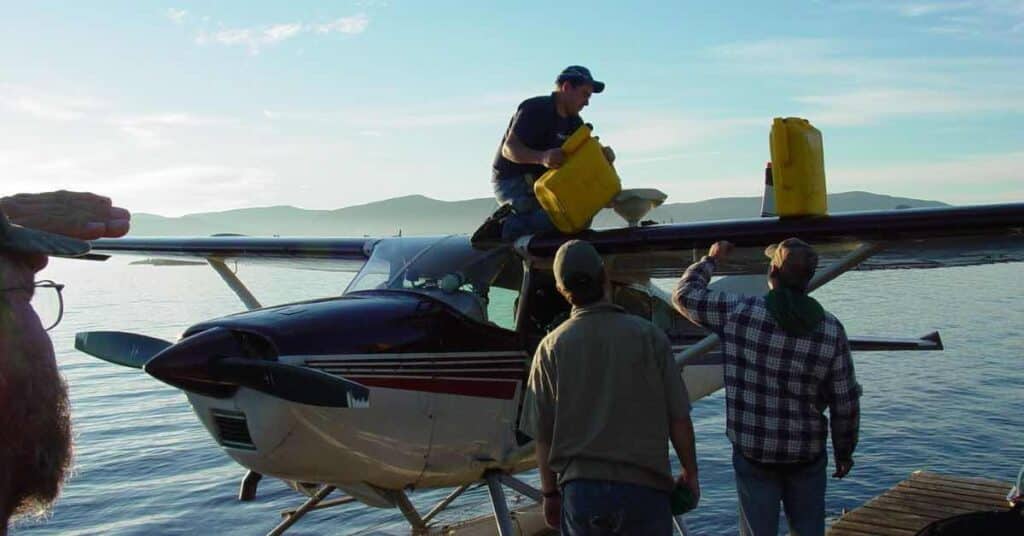
The float plane made two separate trips into the hunting camp known as Cat Arm. The first remote fly trip included my friend Doug and his brother-in-law, who was also named Doug. I stood at the dock of the lake, watching them board the small float plane with minimal gear. Some of their gear was left behind at the dock to be sent into camp on the flight that I would be taking.
Fuel Dump Dilemma
Watching the plane skim across the still lake was fun to watch. The excitement was becoming a reality that we were finally at the doorstep of this lifetime adventure of hunting moose. Excitement of the unknown that was ahead of us and the journey that would soon fulfill lifelong dreams.
As the plane attempted to lift from the lake surface, Leonard stated that they seemed to be having problems lifting from the lake surface. He noticed the pilot was dumping fuel in an attempt to get the lift he needed to become airborne. The roar of the plane’s engine came to a silent purr, and it was then evident that the plane was too heavy to lift. This meant that the plane had to return to the dock and the weight had to be lessened in order to fly.
Doug’s Uncharted Adventure
After this brief return to the dock, the plane then attempted a second departure and then successfully lifted into the clear blue sky. I will be honest and say that at this point, I welled up with tears of joy knowing that my friend Doug was experiencing something that he could have never imagined in his lifetime. I was so overjoyed for him having this experience.
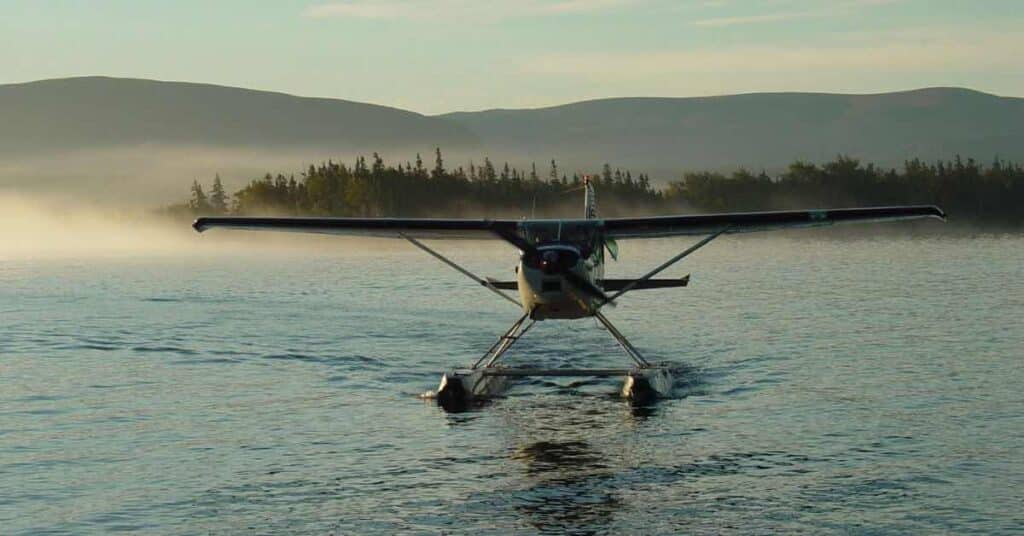
For it was he who pushed me along to get into bow hunting only to discover it would become my true passion. I could just see the smile on Doug’s face as the plane gained altitude and flew over the mountaintop and out of sight. This was HIS adventure as well, and he would be ready for it.
Final Destination: Daniel’s Harbour Area
About an hour and a half later, the float plane returned to the small lake on the outskirts of Daniel’s Harbour. It was time for me to depart on the last leg of our journey and arrive at Cat Arm. The flight was an amazing experience.
Flying solo with all the gear for camp, I watched the pilot expertly maneuver the small aircraft across the calm lake and into the blue skies. He pointed out cool rock formations and ancient Indian drawings on the mountainsides as we flew. Gazing down at the land below, I eagerly scanned for moose but instead spotted migrating Caribou, majestic with their big antlers and white coats. It was an awe-inspiring view from above.
Float Plane Experience
After a brief flight, the pilot informed me that we would be descending onto the lake, my camp for the next week. It felt like the pilot was channeling Maverick from “Top Gun” as he executed a sharp banking turn, leaving me grabbing for balance. With nothing but blue sky followed by the water of the lake rushing into view, I held on tight as we made our approach.
We landed softly on the lake, the spray from the water off the pontoon floats indicating our safe arrival. On the shore, I spotted the cabin where I’d be staying, with Doug and his brother-in-law standing on the dock, grinning from ear to ear. As I disembarked, Doug greeted me warmly, handing over a change of underwear with a memorable quip about our accommodations. We were finally here, ready for our moose hunting adventure!
Getting Settled at Camp
Arriving at camp was the realization that we were truly off the grid. No electricity, no running water, and a camp heated by a wood stove. The sleeping quarters were set up in a small cabin for each of us, and the cook tent was where we would gather for meals. Water was pumped from the lake for cooking, and a small stream nearby provided water for washing.
No Sunday Hunting
Hunting is not allowed on Sundays in Newfoundland. This rule provides an opportunity to acclimate with the surroundings and get to know your guides, as well as the plan for the upcoming week’s hunting activities. The rest of the day flew by as we unloaded gear and settled in. We met our guides and Edna, the camp cook, who treated us to delicious corned beef sandwiches on homemade bread for lunch. Each camp boasts a skilled cook who provides meals throughout the entire stay.
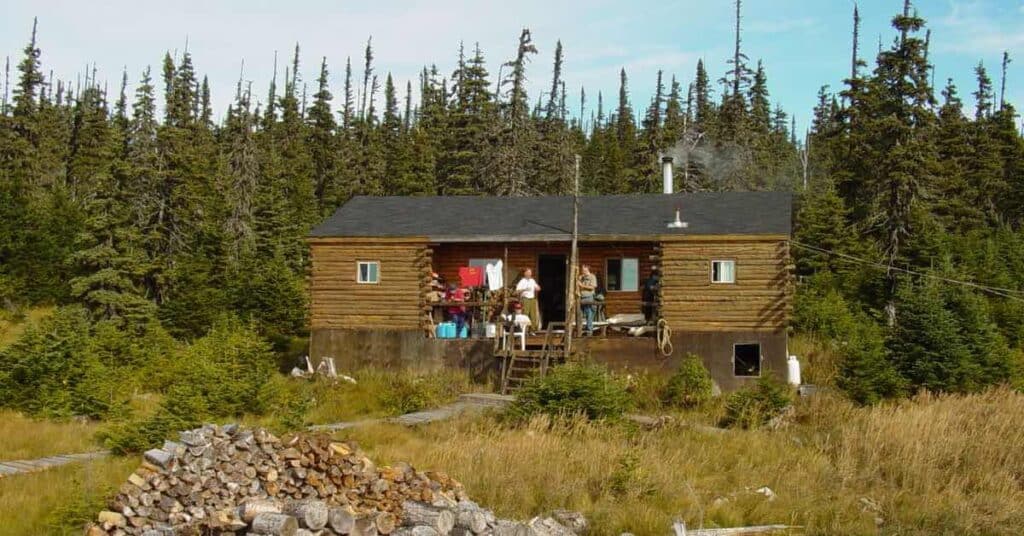
Eager to bond with everyone, I offered to help Edna with the dishes after our meal. Her cooking reminded me of some our family’s favorite venison recipes. It was a fun time swapping stories about our families. Later in the afternoon, we took a walk around, soaking in the surroundings and discussing the weather. We spent the evening around a fire outside the cook tent where we could share stories and listen to the calls of the loons on the lake.
Our hunt would begin at 4 a.m. the next morning, so we turned in early for a much-needed night of sleep. The next day marked the official beginning of our hunting expedition. A hearty breakfast was prepared for us to keep everyone fueled for the day ahead. Each hunter was paired with a guide, and we embarked on a boat journey across the lake to reach our assigned hunting spots.
Moose Hunt Day One:
Day One of the Moose Hunt was quite the adventure. My guide, Alvin, an older gentleman in his early fifties, had already been hunting for three weeks before my arrival. Setting out at 4:30 am, I followed Alvin’s lead, taking in the sunrise as we traversed marsh-like terrain. Each step felt like sinking into wet grass up to 12-16 inches. I marveled at Alvin’s endurance while I struggled to keep up, sweating profusely and soaked to the bone.
After 2-3 hours of trekking, we settled in a cluster of trees to glass the area and call moose. Alvin taught me some calling tricks, impressed by my choice of a birch bark moose call. Despite our efforts, we didn’t spot any moose, so we rested briefly before changing socks and pressing on.
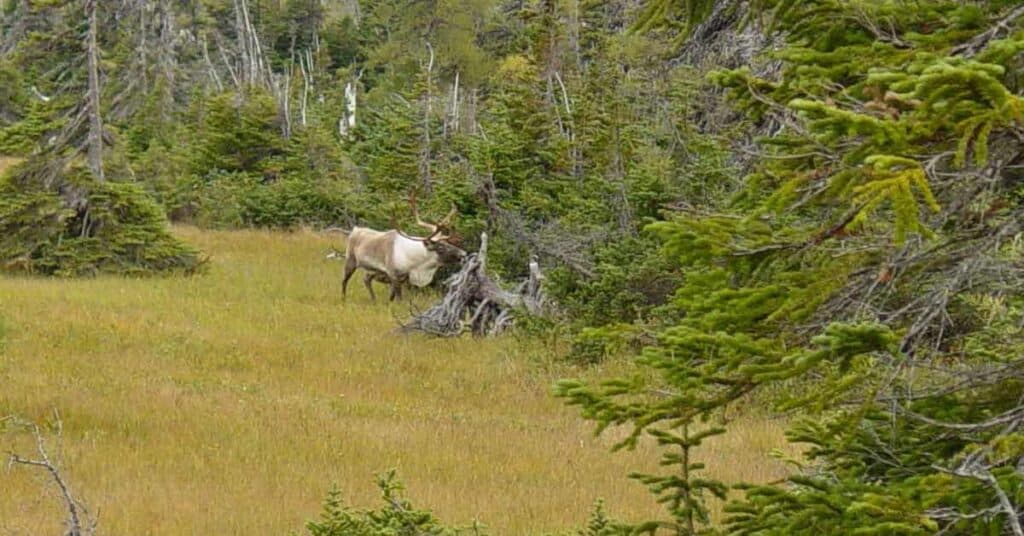
Caribou Success
During our hunt, we learned Doug and his brother-in-law had bagged some Woodland Caribou. Despite our efforts, we returned to camp empty-handed around 11:30 pm. Edna had prepared a hearty dinner of turkey, mashed potatoes, stuffing, corn, and homemade bread. Gathering around the table, we shared stories of our day’s adventures, the warmth of the cabin lulling me into a peaceful slumber, grateful for the friendships made and eager for another day’s hunt.
Moose Hunt Day Two:
Once again, I found myself waking up at 4 am, ready to hit the trail by 4:30 am. But something was wrong—I couldn’t move! The physical conditioning needed for a successful moose hunt was staring me straight in the face. My bunk buddy Doug, however, had boundless energy. As soon as he woke up, he began chanting, “Here Moosey Moosey,” our designated mantra. Despite my mood, Doug enlisted the help of the guides and Edna, our great cook, to rouse me from my slumber.
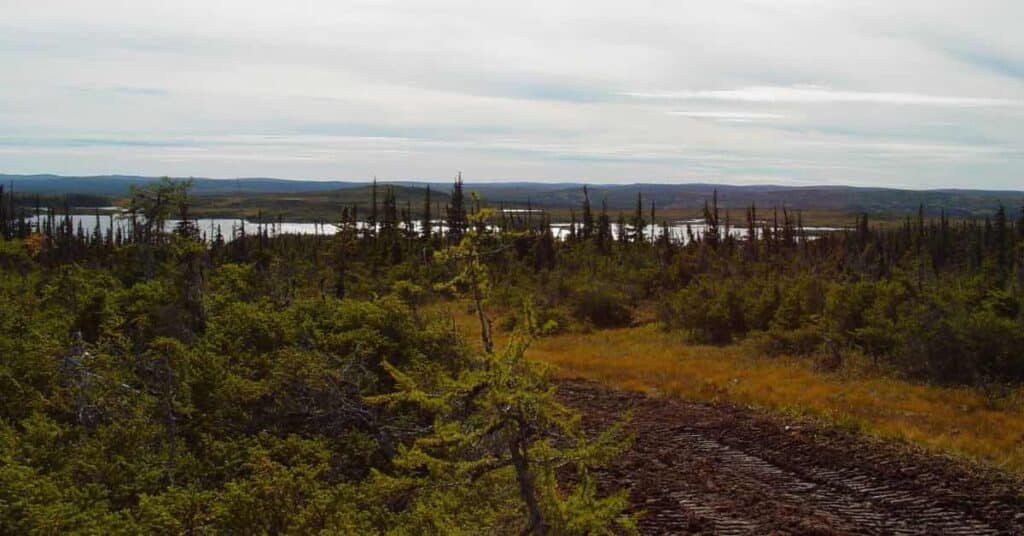
They even filmed the event, capturing my struggle to get out of bed. Despite my soreness, Alvin, my guide, urged me to empty my backpack except for a pair of socks and take some ibuprofen. Eventually, I stumbled out into the darkness, ready for day 2 of the hunt.
After an hour of walking, my body began to cooperate. We paused to snack on cinnamon rolls, courtesy of Edna, and refuel with Gatorade. Alvin then informed me of our new direction and the distance we’d cover—15 to 18 miles, sans swampy terrain.
First Moose Sighting
As the sun rose, Alvin suddenly signaled for me to stop. Ahead, a cow moose crossed our path followed by her young calf. It was my first sighting of wild moose, and I was captivated by their majestic presence.
Throughout the day, we stopped at various spots, calling and glassing for moose, but with no success. Despite the silence from Alvin, his occasional offer of candy kept our spirits up. By the end of the day, despite the lack of success, I felt settled into the rhythm of hunting and remained patient and focused, ready for whatever the next day would bring.
Moose Hunt Day Three: Success for My Friends
As we geared up for day 3, anticipation filled the air. Departing slightly later than usual at 4:30 am, our plan was to hunt closer to camp, hoping for a change of luck. Midday brought news of Doug’s success—he had bagged a bull moose, becoming the first in camp to do so. Soon after, we received another radio call—moose number 2 was down; brother-in-law Doug had also scored his trophy.
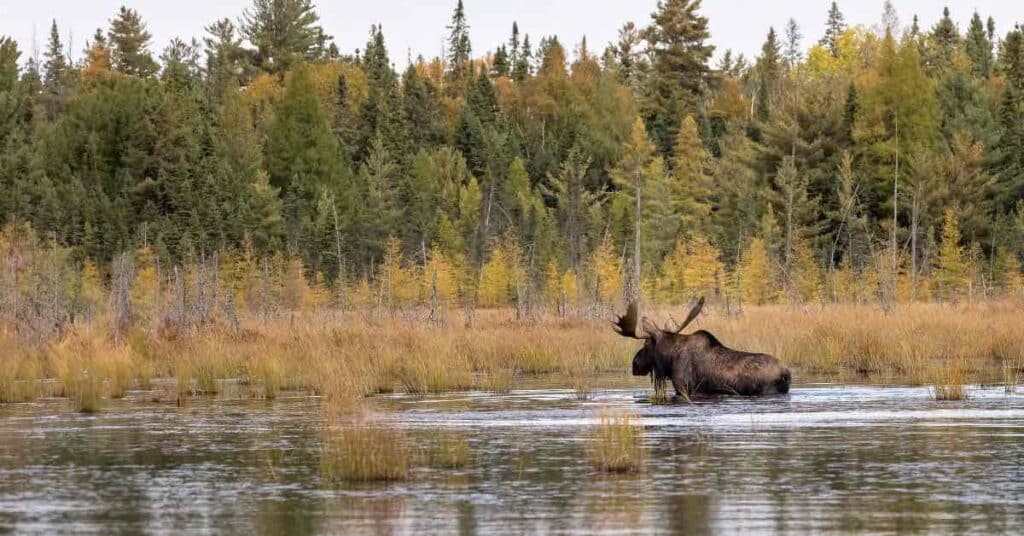
Excitement bubbled within me, fueled by their success. Though my own hunt didn’t yield results that day, returning to camp to the sounds of jubilation and storytelling reignited my enthusiasm. Doug, ever the showman, treated us to a video recounting his successful hunt. Far from being bothered, I found myself invigorated by the tales, eagerly anticipating my own chance at success.
Moose Hunt Day Four: Big Game Success
Thursday morning marked the second-to-last day for my chance at a bull moose. Alvin and I set out early, feeling refreshed. Alvin had been listening to the weather report over the radio, and it did not sound like we were going to have a wet day of walking. This became an understatement. Alvin and I walked for miles and miles with no signs of moose. The wind was blowing, and the rain was falling at an alarming rate. We were walking in weather that was the fallout of a hurricane moving up the coast. We were now in the tail end of the storm.
Hunting Fatigue Sets in
As the day unfolded, even Alvin seemed a bit uncomfortable hunting in these conditions. At one point, we stopped to take a break from the rain and have some lunch. Alvin then indicated that he would build a fire and warm up. “Build a fire? Are you kidding me? How in the heck was he planning to do this?” I thought. He sat me down and handed me a backpack full of sandwiches courtesy of Edna. Alvin then proceeded to start a fire using a piece of birch bark that he kept in his backpack. I learned a lesson that day from watching him build a fire in that rainstorm. It was so cool to see his determination to get a fire going.
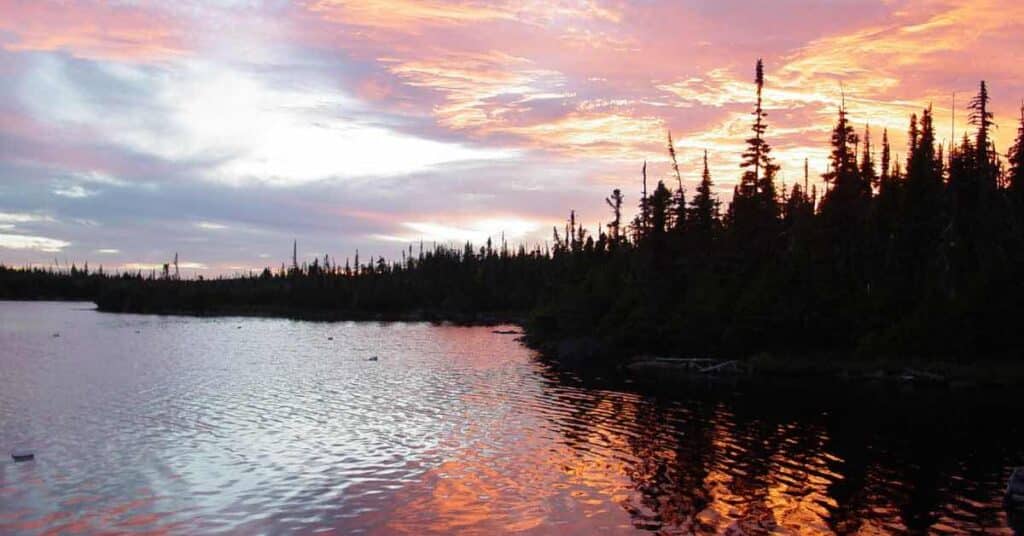
Renewed Energy to Continue
That fire sustained us for the moment and gave us the strength and determination to move on for the rest of the day. After that brief break around the fire, we packed up and headed on our way. We were back on task and had a plan that needed to be executed. We hiked for a few miles and found ourselves on the top edge of a mountain overlooking a lake below. As we sat there glassing and calling, I began to ask myself how on earth would we find moose from this vantage point. The lake below us was at least a mile away and nearly straight down the mountainside.
A Moose in Our Sights
As calm as Alvin could be, he leaned over and asked me if I was ready to shoot a moose. I looked at him confused, thinking, “What do you think I came here to do?” It was then that he pointed out a moose that he had spotted at the bottom of the mountain near the edge of the lake. I asked him what his thoughts were about going after it, and he said the journey down the mountain to the moose would be very challenging. It was at this moment that I stood up and started walking down the mountainside followed by Alvin. Together we set off in a general line of direction from where we saw the moose. If we stay in a straight line going down the mountain, we should have ended up near the moose.
Newfoundland Terrain
It took nearly 45 minutes to walk and slide down the mountain. When I say slide, I mean on our bottoms sliding down the steep slope. We eventually got to level ground near the edge of the lake and began scanning the area for the bull. Within a few minutes, Alvin spotted the legs of the moose standing behind a pine tree. Alvin asked me if I could see the moose, and I responded with a nod of the head that yes, I was on him. I had set up to take aim at the moose from a kneeling position. I had plenty of time to get settled for the shot. Using the aid of a shooting stick, I took aim at the moose.
Calling My Moose
I noticed that while taking aim at the moose, I was raising the barrel of the gun in an upward position. I could feel that my point of aim had to be much higher due to the height of the moose. At the time of taking the shot at the bull moose, I was a mere twelve yards away from my target, which was still standing behind the pine tree. Behind me, Alvin was setting up to make a brief call of a cow moose to get the bull to step out from behind the tree. With one short call, the bull stepped forward, and I softly pulled the trigger. The sound of the Remington 300 Win Mag let out a bark that could be heard for miles.
Tracking My Moose:
The moose bolted toward the lake. We paused, listening for its crash through the trees, but heard nothing. Alvin and I huddled, munching candy, relishing the absurdity. We chuckled, envisioning the task ahead: retrieving a moose from the mountain we’d just descended. We ventured forth, finding scant blood. Perplexed, we followed the moose’s trail to the lake’s edge.
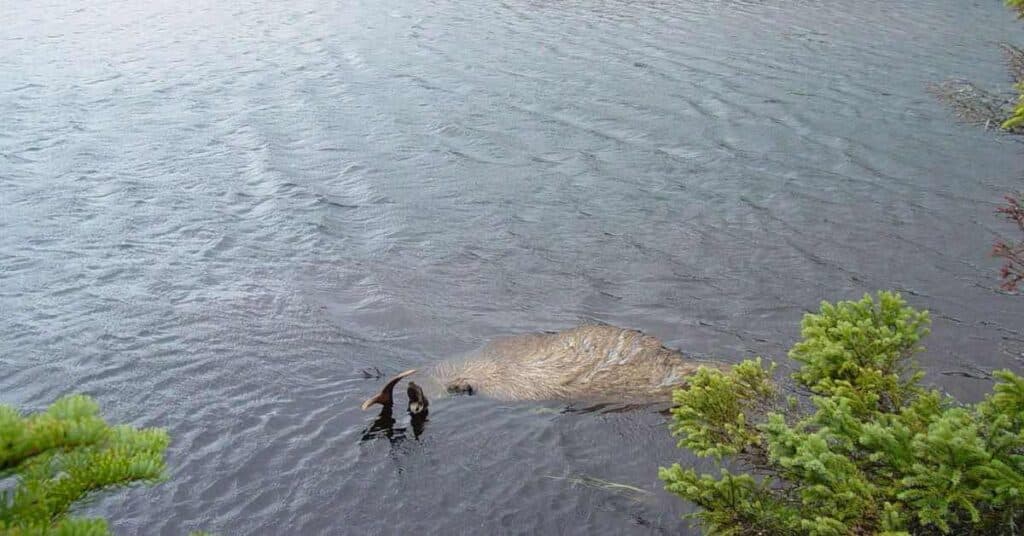
Expecting a quick discovery, we searched in vain. Alvin, scanning, disappeared around a bend, then called me over. I rounded the corner to find him grinning, pointing to the floating moose. A surge of pride overwhelmed me, imagining my dad’s praise.
Alvin, undeterred, prepared to swim. Stripping to his underwear, he tethered the moose’s horns and dragged it ashore. Together, we hauled it to land, my trophy finally in reach—a moment etched in memory. Next, we field-dressed the moose, knowing a 14-mile hike awaited us.
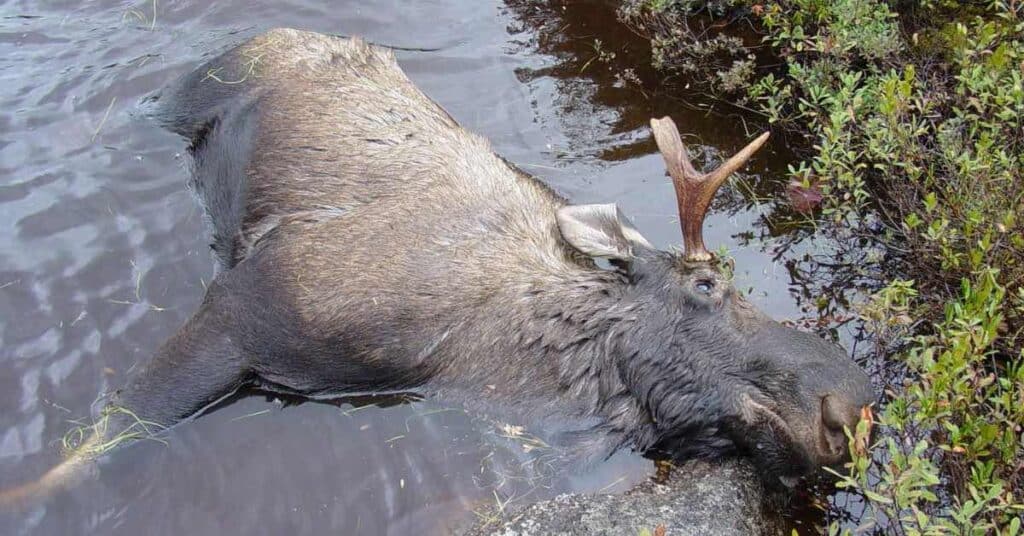
As dusk approached, we reminisced on the journey. Alvin confessed to never bagging a moose here due to the rugged terrain. Silently, we returned to camp, surprising Doug, asleep on the sofa. I whispered, “Here Moosey Moosey,” presenting him with the shell casing. His eyes lit up, the cabin erupting in cheers. Our Newfoundland hunt had ended triumphantly.
Harvesting a Newfoundland Moose
The next morning, additional guides flew into camp to assist with the moose recovery. Using a rickety old skidozer, we set off. With five pairs of hands, the entire day was dedicated to bringing the moose back. Recovery day proved as challenging as the previous ones, navigating the difficult terrain. Eventually, we returned to camp, the moose in tow.
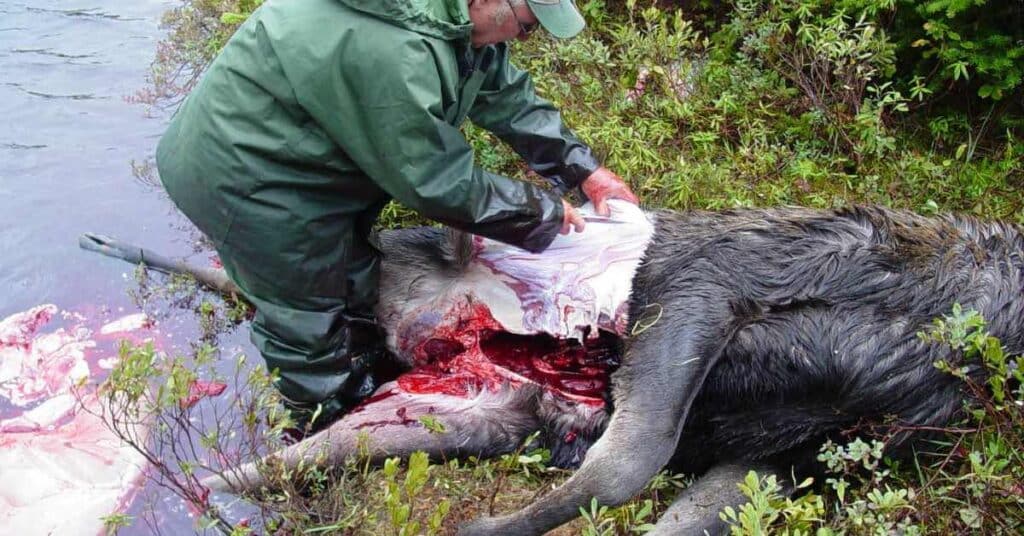
Over the remaining days, the moose meat was flown out for processing. We savored one last day in camp, making memories and conversing with newfound friends. On our departure day, as we gathered our gear at the dock, a fresh group of hunters arrived, eager for their own adventures. We exchanged brief tales of our week and bid them well, leaving Cat Arm behind, our hearts filled with stories.
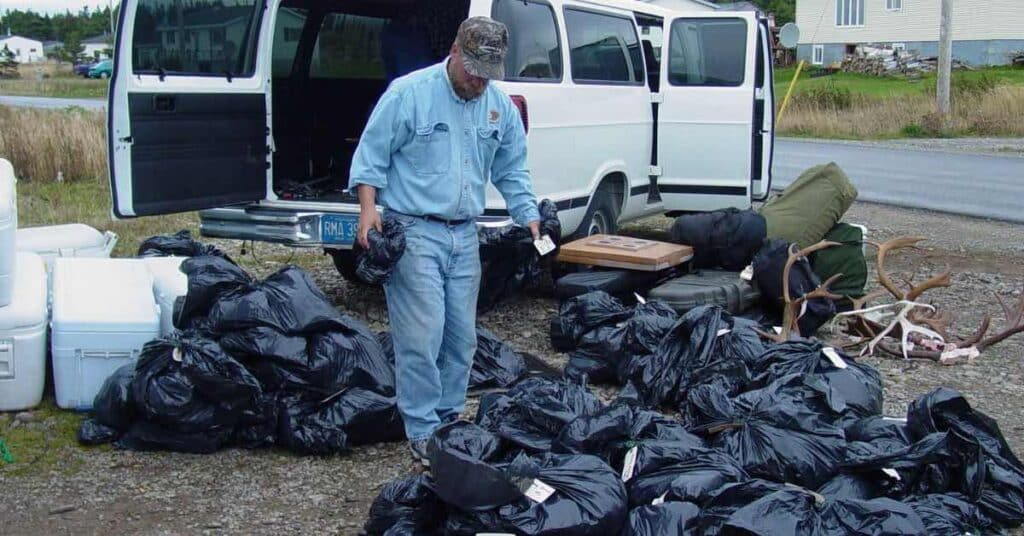
Successful Moose Hunting in Newfoundland
The journey home mirrored our arrival, albeit in reverse. Within two days, we reunited with our families, exhausted yet fulfilled, reliving our triumphs. This experience bolstered my confidence, a testament to perseverance. Twenty years on, I gaze at the moose on my living room wall, surrounded by other trophies. Each holds significance, but none rival the memories of that Newfoundland moose.

